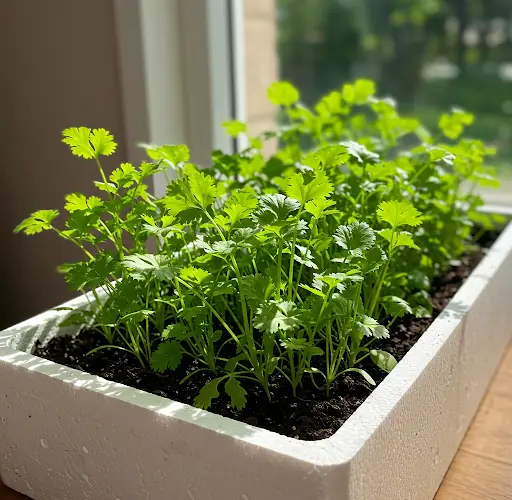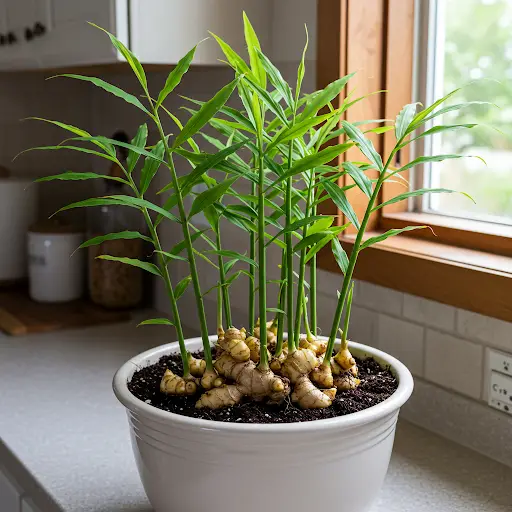Growing Coriander in a Styrofoam Box – Beautiful, Simple, and Space-Saving
Coriander, also known as cilantro or Chinese parsley, is a beloved herb in many cuisines around the world. It’s aromatic, easy to grow, and incredibly useful in cooking—whether you’re adding fresh leaves to salads, garnishing soups, or using the seeds as a spice. One of the most convenient and visually appealing ways to grow coriander at home is in a Styrofoam box.
Using a Styrofoam container for gardening may seem unconventional, but it’s actually a smart and efficient solution. Lightweight, insulating, and often free (as packaging material from food or electronics), Styrofoam boxes are perfect for balcony or rooftop gardens, especially where space and resources are limited. And when planted densely, coriander looks lush and beautiful—a perfect addition to any green corner of your home.
Why Choose a Styrofoam Box to Grow Coriander?
Here are some great reasons to try this method:
-
Cost-effective: Styrofoam boxes are often free and easy to find.
-
Good insulation: Protects plant roots from heat and cold.
-
Lightweight and portable: Easy to move for optimal sun exposure.
-
Spacious: Offers enough room for multiple coriander plants.
-
Attractive appearance: A box full of bright green coriander is surprisingly pretty!
This method works especially well for small spaces such as balconies, terraces, windowsills, and patios.
What You’ll Need
To get started, gather the following materials:
-
A clean Styrofoam box (fish or produce boxes work well)
-
A sharp knife or scissors
-
A few small stones or broken tiles (for drainage)
-
Quality potting soil or homemade soil mix
-
Coriander seeds (split or crushed for better germination)
-
Watering can or spray bottle
-
A spot with partial to full sunlight
Preparing the Styrofoam Box
1. Clean and Modify the Box
-
Wash the Styrofoam box thoroughly to remove any dirt or odors.
-
Using a knife or screwdriver, poke 5–7 drainage holes in the bottom to allow excess water to escape. This is crucial to prevent root rot.
-
Optionally, make a few small holes on the sides near the bottom for extra airflow.
2. Add Drainage Layer
-
Place a layer of small stones, gravel, or broken tiles at the bottom of the box. This helps improve drainage and keeps the soil from becoming soggy.
3. Fill with Soil
Use a light and well-draining soil mix. A good recipe is:
-
50% garden soil or cocopeat
-
30% compost or decomposed manure
-
20% sand or perlite for aeration
Fill the box about 3–4 inches deep with the soil mix, leaving a little space at the top to prevent soil from spilling out when watering.
Sowing Coriander Seeds
1. Prepare the Seeds
Coriander seeds are actually two seeds joined together. For better germination:
-
Lightly crush the seeds between your fingers or using a rolling pin to split them into two halves.
-
Soak them in water for 4–6 hours to soften the seed coat and speed up sprouting.
2. Planting the Seeds
-
Sprinkle the soaked and split seeds evenly over the surface of the soil.
-
Gently press them into the soil or cover with a thin layer (about 0.5 cm) of soil.
-
Water lightly with a spray bottle or watering can to moisten the surface.
Caring for Your Coriander Plants
Light:
Coriander prefers 4–6 hours of sunlight per day. Place the Styrofoam box where it can receive morning sun and some afternoon shade, especially in hot climates.
Watering:
Keep the soil consistently moist but not waterlogged. Water once daily or when the top layer feels dry. In cooler weather, reduce the frequency to prevent overwatering.
Fertilizing:
Feed your coriander every 10–14 days with a diluted organic liquid fertilizer such as compost tea or seaweed solution. Avoid heavy feeding, as coriander grows best in moderately rich soil.
Thinning:
When seedlings grow to about 2–3 inches tall, thin them out gently by removing the weaker ones, leaving 2–3 inches between each plant. This allows enough space for the rest to grow full and bushy.
Harvesting Coriander
Coriander is typically ready to harvest in 3–4 weeks after planting, depending on climate and care. You can harvest in two ways:
-
Cut-and-come-again: Snip the outer leaves when they reach 4–6 inches tall. This allows the center to keep producing new growth.
-
Full harvest: Cut the entire plant just above the soil line if it begins to bolt (produce flowers), especially in warmer weather.
For the freshest flavor, harvest in the early morning or late afternoon.
Tips for Success
-
Grow coriander in cool to mild temperatures; it tends to bolt quickly in extreme heat.
-
For continuous harvests, sow a new batch of seeds every 2–3 weeks.
-
Keep an eye out for pests like aphids; if needed, spray neem oil or use natural pest control methods.
Final Thoughts
Growing coriander in a Styrofoam box is not just practical—it’s a beautiful and sustainable way to enjoy fresh herbs from your own home. With minimal materials, effort, and space, you can create a lush, green container full of flavor and life.
Whether you’re an experienced gardener or just starting out, this method proves that with a little creativity, anyone can grow their own food—even in the smallest of spaces.



